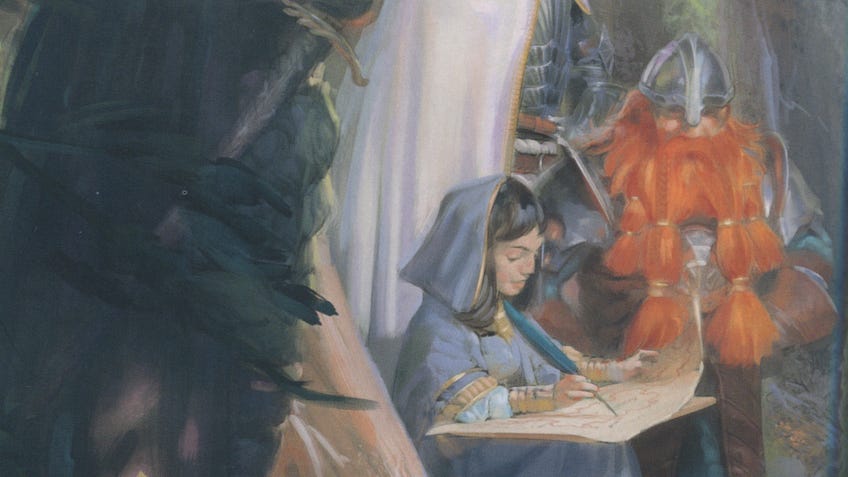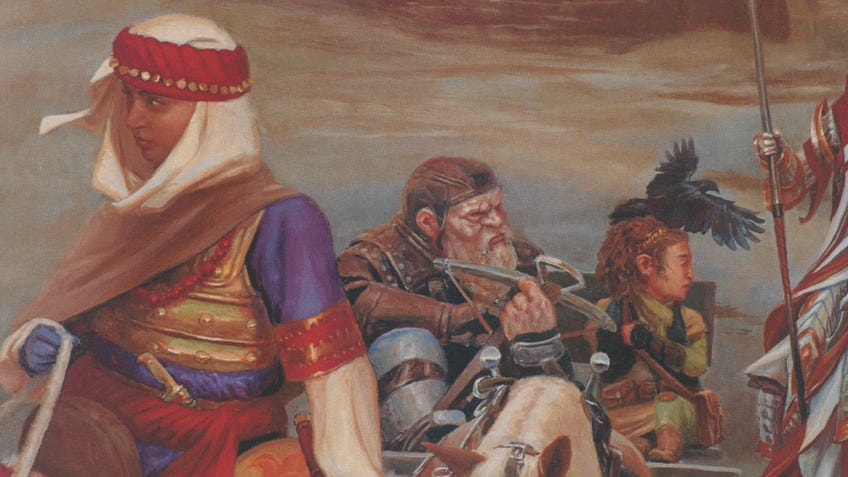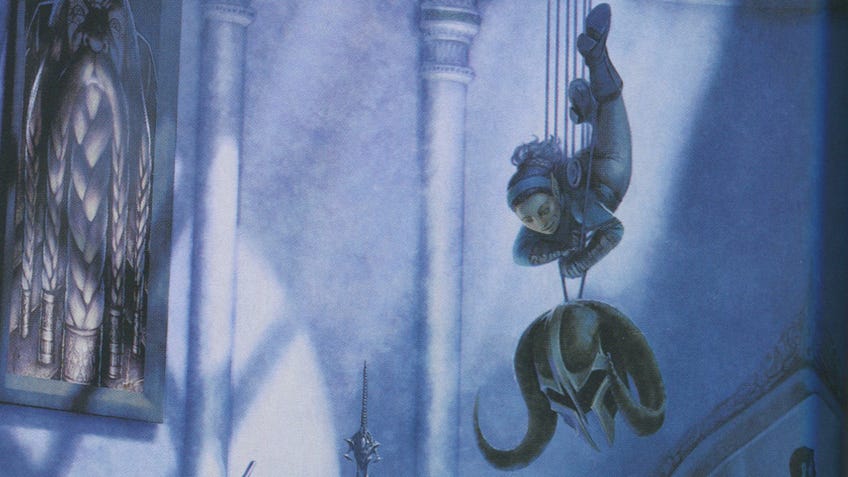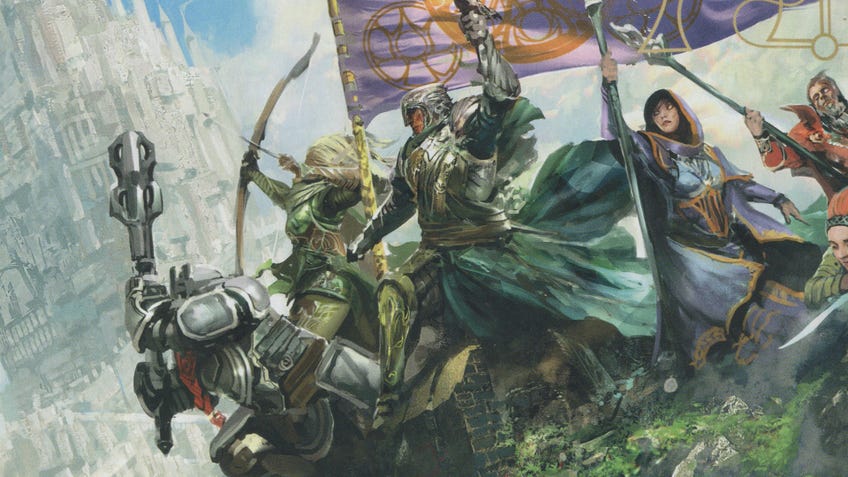Dungeons & Dragons 5E rogue class explained
Rogues mean shifty business.
Doing crimes isn’t inherently cool. But, in Dungeons & Dragons 5E, being a rogue and doing crimes is. (Disclaimer: please don’t actually do any crimes.)
Rogues have an innate sense of capability and cunning about them. They’re better than other D&D character classes (compare how they all stack up in our Dungeons & Dragons 5E class guide), and they know it. Having access to such a wide range of skills and confidently slipping around their foes’ clumsy attacks grants the rogue class an element of smugness that’s rightfully theirs.
Despite our earlier statement about crime being cool (but actually not cool), rogues don’t necessarily have to apply their talents to the criminal arts. However, thanks to their natural affinity for stealth, rogues are at their best when skulking through darkened streets or lurking amongst the shadows.
Rogues don’t give out their damage in waves, like some of D&D’s other martial combat classes (e.g. the barbarian or fighter). No, the rogue’s approach to combat is all about choosing the right time to strike and hitting where it hurts. They’re certainly not the biggest team player of the bunch, but they more than make up for it with the sheer number of useful skills they bring to the party.
For now, let’s have a look at what rogues have got to work with at first level.
Choosing your rogue skills, equipment, and expertise
When creating a rogue, those aforementioned useful skills come into play from the very start, as the first thing you do is to select four skills to gain proficiency in. If you’re unsure what proficiency exactly means, go and have a gander at our tips on how to create a Dungeons & Dragons 5E character. Otherwise, you can choose to gain proficiency in acrobatics, athletics, deception, insight, intimidation, investigation, perception, performance, persuasion, sleight of hand and stealth.

With such a large pool of skills to choose from, it might be hard to suss out what’s going to work best. It does help to have a good think about the way you think your rogue likes to go about things. Do they climb city ramparts and leap onto rooftops to run away from suspicion? Consider taking some acrobatics and athletics. Are they con artists with the gift of the gab and twitchy fingers? Then grab some proficiency in persuasion and sleight of hand. Of course, with the ability to take four skills you could just build your rogue in either of the above ways, or simply focus on giving them as well-rounded a skillset as possible.
Whatever skills you choose are then further developed through the Expertise ability, which allows you to gain a double proficiency bonus in either two of your selected skills or one skill and a set of thieves’ tools. Thieves’ tools are included in one of the equipment sets you’ll get (more on that in a bit), and are essentially an assortment of items that’ll allow you to break into places you’re not supposed to go (amongst other things). Crucially, they contain a set of lockpicks, which happen to be incredibly handy even if you’re not planning on breaking-and-entering for the express purposes of theft. Which is why it might be a good idea to forgo that extra proficiency bonus on a skill, in favour of gaining proficiency in thieves’ tools. Obviously, the choice depends on whether you want your rogue to be the sleuthing type, or something a little more smash ’n’ grab.
The last choice you’ll be making at first level is what equipment you want to take. Rogues are proficient in a surprisingly wide array of weaponry, including ranged weapons like hand crossbows and more melee-focused affairs like longswords and rapiers, so you’ve got your pick of the bunch when it comes to martial equipment. You will have to choose between the (a) and (b) options of each equipment set but, no matter what you pick, you’ll be getting a melee weapon regardless. It’s whether you want to double up on the melee weapons or dabble a little in ranged weaponry that will decide if you take the shortsword or shortbow.

From there, it’s a simple case of selecting your pack of choice between the burglar’s pack, dungeoneer’s pack, or explorer’s pack. The burglar’s pack rather speaks for itself; expect tools that enable you to access forbidden places - a hammer, crowbar and so on. The dungeoneer’s pack is rather similar to the burglar’s pack, except you get a little more general versatility with some torches and rope. The explorer’s pack leans even more into this versatility aspect, by providing a mess kit and bedroll alongside the torches. It’s not exactly the most important choice you’ll make when creating your rogue, but it’s certainly worth pondering over a bit.
What is Sneak Attack in D&D 5E?
Sneak Attack is the rogue’s signature move. They gain access to it straight away, and continue to hone the ability with every level reached, making it one of the most powerful tools in their deadly arsenal.
A standard attack can be pulled off using our guide to how to create a Dungeons & Dragons 5E character, otherwise a Sneak Attack enables you to deal an extra d6’s worth of damage to your opponents, which is already a pretty impressive amount at level one, but it will eventually go all the way up to rolling 10d6 - or ten six-sided dice - at 20th level. This ability is a really great way of laying on some heavy damage in just a single hit, potentially removing an enemy from the battlefield before they even have a chance to act.
How to use sneak attack
Certain prerequisites need to be met before you can actually perform a Sneak Attack.
If you have advantage on an attack roll then you can use Sneak Attack on an enemy your character successfully hits. Otherwise, you’ll need to have at least one ally standing five feet or less from your intended target. That ally needs to be threatening that target, and you cannot have disadvantage on your current attack roll (also, the enemy cannot be incapacitated). If all these criteria are met, then you’ll be able to perform Sneak Attack on the enemy in question. Be aware, though - you can only use Sneak Attack once per turn.
Using Cunning Action, Uncanny Dodge and Evasion
Being as slippery as an eel, rogues have the ability to manoeuvre out of harm’s way, mostly.
You’ll experience this first bout of slipperiness with at second level, with the Cunning Action ability. A player’s turn in Dungeons & Dragons 5E usually involves a standard action, a move action and a bonus action. Now, bonus actions are rarely that useful. However, with Cunning Action, your rogue will be able to use their bonus action to either Dash, Disengage or Hide.
- Dashing allows you to take double your movement speed. Meaning, that if your movement was just 30 feet, you could actually move 60 feet in a single turn.
- Disengage enables you to move without provoking any attacks of opportunity. If you haven't got a clue as to what an ‘attack of opportunity’ is, have the Dungeons & Dragons 5E terms explained to you in our handy jargon-buster.
- Hide gives you the chance to roll a stealth ability check to attempt to hide in the midst of battle, which makes enemies roll at a disadvantage whenever they try to attack you.
Having access to these bonus actions makes your rogue more dexterous in combat, able to bounce and sneak across the battlefield, all whilst avoiding any hits in-between.
This level of combat dexterity further increases when you hit level five and you gain access to the Uncanny Dodge ability. If an enemy does happen to land a hit on you, with Uncanny Dodge you can use that turn’s reaction to half the damage you receive. Either way, Uncanny Dodge enables you to reduce at least one hit’s worth of damage, sometimes down to a single point.

Your final method of evasion is called… Evasion, literally. This talent emerges at seventh level, and despite being a tad more specific than Uncanny Dodge, is arguably more useful. During your journey through the dangerous world of D&D, you’ll likely encounter various area-of-effect spells, which may require you to make a successful dexterity saving throw in an attempt to take only half damage (roll a d20 and add your saving throw modifier). However, with Evasion, a success won’t just half the damage you receive, it’ll reduce it down to a tidy zero sum, potentially turning a complete disaster into a mere trifle. When you consider that dexterity will likely be one of your rogue’s highest ability scores, there’s probably a good chance that evasion will come in useful.
Choosing your rogue’s archetype
As with all of Dungeons & Dragons’ classes, third level means choosing which subclass you want your character to specialise in.
In this case, you’ll be picking from the three roguish archetypes featured in the Dungeons & Dragons 5E Player’s Handbook. There are other roguish archetypes out there, no doubt about it, but they’re either consigned to specific Wizards of the Coast source books such as Xanathar’s Guide to Everything - one of the best sourcebooks for Dungeons & Dragons 5E - or floating around the murky waters of D&D 5E homebrew content. So we’ll be sticking to the standard rogue stuff, at least for now.
The roguish archetype you choose will widen your pool of nefarious talents, but will also set your character on a particular path, one that’ll either emphasize a certain approach to combat or how they interact with the world at large (sometimes both). Whatever archetype you set your heart on, you’ll be shaping your rogue in a surprisingly unique way, as roguish archetypes differ more than you’d think.
Thief archetype

The thief archetype is the odd duck of the group, concentrating more on weird little talents that have some utility over any significant level improvements.
As the name suggests, this archetype pushes your rogue down the more larcenous (an excellent word) path of criminality. If you’ve already selected proficiency in thieves tools over an additional proficiency in another skill, then this archetype might be just what you’re looking for.
In fact, the very first talent you get actually utilises the thieves’ tools. Fast Hands enables you to use the bonus action you get from the Cunning Action ability (granted at second level), to also make a sleight of hand check, disarm a trap or open a lock (using the thieves’ tools), or use an object. This talent gives your rogue options beyond just saving their own skin, potentially opening up new paths when you and your party most needs it.
If you were imagining your rogue as an Indiana Jones type, then the thief archetype leans heavily into bringing this dream to light. Second-Story Work (gained at third level) and Supreme Sneak (gained at ninth level), are both very evocative of the traditional ruins-explorer toolset, as they boost your ability to climb, jump and sneak. What’s more, with the talent Use Magic Device, your rogue will be able to pick up the treasures they find and improvise using them, regardless of which class, race or level they’re intended for. Which is fun.
Assassin archetype
If you’re more interested in creating a damage-dealing rogue, perhaps consider taking the assassin archetype instead. Assassins are your traditional cut-throats, geared towards causing as much harm in as little time as possible. However, this doesn’t necessarily mean that their repertoire is limited only to stabbing, slashing and shooting from the shadows. Assassins are also masters of disguise and deception, lulling their enemies into a false sense-of-security before actually doing the stabbing/slashing/shooting.
This can be seen in the bonus proficiencies in disguise and poisoner’s kits that assassins instantly receive, which enable the user to fool and weaken their chosen targets before the inevitable flash of the knife. These abilities are further fed by the Inflation Expertise (gained at ninth level) and Imposter talents (gained at 13th level), wherein rogues can confidently create false identities or expertly pretend to be another person. These talents prove incredibly useful when having to set up certain favourable situations for your D&D party, like scouting out an otherwise inaccessible location or trying to escape a particular dangerous individual.

Where assassins really shine is in their mastery of the stealth kill. They’re immediately gifted with the Assassinate talent, which allows the player to roll advantage whenever they’re attacking an enemy that hasn’t yet taken their turn during combat. Additionally, whenever you successfully hit a surprised enemy (an enemy that isn’t yet in combat), your rogue gets to deal out all the benefits of a critical hit. Combine this talent with the already powerful Sneak Attack, and you’ve potentially got a character that’s built to instantly take out enemies.
Arcane Trickster archetype
Whereas the assassin uses a figurative kind of magic to confound their enemies, arcane tricksters use literal magic to bamboozle their unfortunate targets. Through some bizarre twist of fate, come third level and your rogue can suddenly employ the sorcerous arts to beguile and bewitch.
Taking the arcane trickster archetype grants you access to the wizard’s spell-list, which ourDungeons & Dragons wizard class guide covers, with each ascending level granting your rogue new opportunities to learn spells in the Enchantment and Illusion schools of magic. For reference as to how many spells you can learn and cast each level, have a look at the table shown on page 98 of the D&D 5E Player’s Handbook. As your rogue hits the higher levels, they’ll get select opportunities to take spells outside of the Illusion and Enchantment schools as well. This is the big draw of the arcane trickster; the sheer potential for creating a rogue holding the exact tools they need (more or less).
Alongside this, you’ll also get some universal arcane trickster talents that allow your rogue to do some nifty little things. For example, every arcane trickster has a unique version of the classic Mage Hand cantrip, which enables them to use that spell to steal things from other people (something that the standard version of Mage Hand doesn’t otherwise allow). Mage Hand only gets more wild with the Versatile Trickster talent gained at 13th level, where your rogue can use the spell to actively distract opponents on the battlefield.
What race should I play as a rogue?
Despite having somewhat answered this question in our guide to how to choose the right character race in Dungeons & Dragons 5E, we figured we’d address it a little more directly here.
Elves are a particularly excellent choice of race if you intend to make a rogue, as they’re naturally dexterous (ability score increase to dexterity), have Darkvision and proficiency in perception. The wood elf subrace grants even more opportunities for your rogue to run-and-hide, whereas the high elf could make an excellent arcane trickster.
Halfling also a great choice of race for making a rogue, for similar reasons as elves are. They benefit from an increase to dexterity, as well as the nimbleness trait; which allows you to move through the space of another creature that’s larger than you. On top of this, the lightfoot subrace of halflings can also hide behind creatures larger them. Giving them even more potential to skulk and sneak.

Another small race, that also happens to be a suitable choice for playing the rogue class, are gnomes. Gnomes have the Darkvision ability, but more importantly, the forest subrace get an increase to their dexterity ability score. Surprisingly, enough being small helps with being unnoticed.
These are just from the selection of standard races provided in the D&D 5E Player’s Handbook; there are plenty more options available in Wizards of the Coast’s other D&D source books such as Xanathar’s Guide to Everything or in the myriad of homebrew content out there.
This guide should give you (almost) everything you need to create the rogue of your dreams. Where you go from there, is entirely up to you and the adventure your rogue goes on. But what if the rogue class isn’t actually for you? Conflicted about what class to play? Perhaps having the other Dungeons & Dragons 5E character classes explained might clear things up for you.









